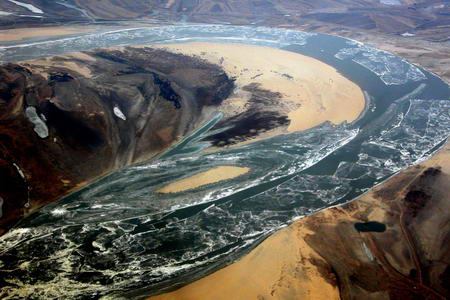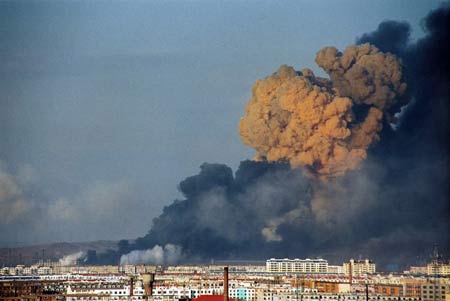On November 13, 2005 in Jilin Province, China, an explosion occurred at a petrochemical plant belonging to the Jilin Petrochemical Corporation. The explosions happened within a time span of an hour and was caused by a blockage in the plant's processing tower. The failed attempt of a worker to clear the blockage eventually led to the explosions taking place, and the following events resulted in five people being killed, dozens being injured, and over 10,000 being evacuated. Approximately 100 tons of toxic chemicals (a mixture of benzene, aniline, and nitrobenzene) were released into the Songhua River, and the chemical slick made its way up the river before eventually flowing into Russia. The polluting of the Songhua River, which was a main water source for many cities, had disastrous chain effects, leading to the eventual shutting off of water in major cities.
WATER CONTAMINATION |
| Image 1 - Image 2 - Image 3 |
The explosions led to a spill of an estimated 100 tons of toxic substances being released into the Songhua River, the largest tributary of the Heilong River. The mixture was a combination of benzene, aniline, and nitrobenzene, which are used to produce certain plastics. Some cities along the river are Jilin, Harbin, and Jiamusi, and the contamination of the water led to the water shutdown for days in the major city of Harbin. People could not shower, but could cook and consume bottled water. The government shipped in emergency supplies of bottled water, and in some cases used fire trucks to supply water to local towns. Over a period of several weeks, the pollution slick ended up flowing into Russia as well, where the Heilong River is better known as the Amur River.
CONTROVERSY SURROUNDING NEWS COVERAGE
Chinese officials initially stated to the press that no pollutants had entered the Songhua River due to the explosion. For five days, factory officials were able to contain and manage the spill themselves without notifying Beijing officials, taking extreme measures such as draining reservoir water into the Songhua in an attempt to dilute the pollutants and claiming that the reason for water shut-off in the major city of Harbin was due to infrastructure repair. It was only until two weeks later when the pollution slick reached Harbin itself that officials felt they could not manage the disaster themselves any longer. The press quickly picked up information regarding the spill, and Chinese authorities were criticized for a lack of transparency with the general public regarding the disaster. International media and environmental protection groups became closely involved with the investigation, implicating high-ranking officials and tracing the chain of responsibility back to the Chinese government.





